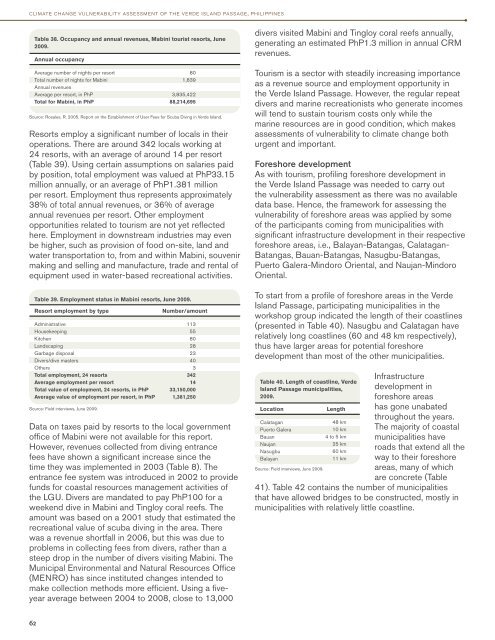of the Verde Island Passage, Philippines - weADAPT
of the Verde Island Passage, Philippines - weADAPT
of the Verde Island Passage, Philippines - weADAPT
You also want an ePaper? Increase the reach of your titles
YUMPU automatically turns print PDFs into web optimized ePapers that Google loves.
climate change vulnerability assessment <strong>of</strong> <strong>the</strong> verde island passage, philippines<br />
Table 38. Occupancy and annual revenues, Mabini tourist resorts, June<br />
2009.<br />
Annual occupancy<br />
Average number <strong>of</strong> nights per resort<br />
Total number <strong>of</strong> nights for Mabini<br />
Annual revenues<br />
Average per resort, in PhP<br />
Total for Mabini, in PhP<br />
80<br />
1,839<br />
3,835,422<br />
88,214,695<br />
Source: Rosales, R. 2005. Report on <strong>the</strong> Establishment <strong>of</strong> User Fees for Scuba Diving in <strong>Verde</strong> <strong>Island</strong>.<br />
Resorts employ a significant number <strong>of</strong> locals in <strong>the</strong>ir<br />
operations. There are around 342 locals working at<br />
24 resorts, with an average <strong>of</strong> around 14 per resort<br />
(Table 39). Using certain assumptions on salaries paid<br />
by position, total employment was valued at PhP33.15<br />
million annually, or an average <strong>of</strong> PhP1.381 million<br />
per resort. Employment thus represents approximately<br />
38% <strong>of</strong> total annual revenues, or 36% <strong>of</strong> average<br />
annual revenues per resort. O<strong>the</strong>r employment<br />
opportunities related to tourism are not yet reflected<br />
here. Employment in downstream industries may even<br />
be higher, such as provision <strong>of</strong> food on-site, land and<br />
water transportation to, from and within Mabini, souvenir<br />
making and selling and manufacture, trade and rental <strong>of</strong><br />
equipment used in water-based recreational activities.<br />
Table 39. Employment status in Mabini resorts, June 2009.<br />
Resort employment by type<br />
Administrative<br />
Housekeeping<br />
Kitchen<br />
Landscaping<br />
Garbage disposal<br />
Divers/dive masters<br />
O<strong>the</strong>rs<br />
Total employment, 24 resorts<br />
Average employment per resort<br />
Total value <strong>of</strong> employment, 24 resorts, in PhP<br />
Average value <strong>of</strong> employment per resort, in PhP<br />
Source: Field interviews, June 2009.<br />
Number/amount<br />
113<br />
55<br />
80<br />
28<br />
23<br />
40<br />
3<br />
342<br />
14<br />
33,150,000<br />
1,381,250<br />
Data on taxes paid by resorts to <strong>the</strong> local government<br />
<strong>of</strong>fice <strong>of</strong> Mabini were not available for this report.<br />
However, revenues collected from diving entrance<br />
fees have shown a significant increase since <strong>the</strong><br />
time <strong>the</strong>y was implemented in 2003 (Table 8). The<br />
entrance fee system was introduced in 2002 to provide<br />
funds for coastal resources management activities <strong>of</strong><br />
<strong>the</strong> LGU. Divers are mandated to pay PhP100 for a<br />
weekend dive in Mabini and Tingloy coral reefs. The<br />
amount was based on a 2001 study that estimated <strong>the</strong><br />
recreational value <strong>of</strong> scuba diving in <strong>the</strong> area. There<br />
was a revenue shortfall in 2006, but this was due to<br />
problems in collecting fees from divers, ra<strong>the</strong>r than a<br />
steep drop in <strong>the</strong> number <strong>of</strong> divers visiting Mabini. The<br />
Municipal Environmental and Natural Resources Office<br />
(MENRO) has since instituted changes intended to<br />
make collection methods more efficient. Using a fiveyear<br />
average between 2004 to 2008, close to 13,000<br />
divers visited Mabini and Tingloy coral reefs annually,<br />
generating an estimated PhP1.3 million in annual CRM<br />
revenues.<br />
Tourism is a sector with steadily increasing importance<br />
as a revenue source and employment opportunity in<br />
<strong>the</strong> <strong>Verde</strong> <strong>Island</strong> <strong>Passage</strong>. However, <strong>the</strong> regular repeat<br />
divers and marine recreationists who generate incomes<br />
will tend to sustain tourism costs only while <strong>the</strong><br />
marine resources are in good condition, which makes<br />
assessments <strong>of</strong> vulnerability to climate change both<br />
urgent and important.<br />
Foreshore development<br />
As with tourism, pr<strong>of</strong>iling foreshore development in<br />
<strong>the</strong> <strong>Verde</strong> <strong>Island</strong> <strong>Passage</strong> was needed to carry out<br />
<strong>the</strong> vulnerability assessment as <strong>the</strong>re was no available<br />
data base. Hence, <strong>the</strong> framework for assessing <strong>the</strong><br />
vulnerability <strong>of</strong> foreshore areas was applied by some<br />
<strong>of</strong> <strong>the</strong> participants coming from municipalities with<br />
significant infrastructure development in <strong>the</strong>ir respective<br />
foreshore areas, i.e., Balayan-Batangas, Calatagan-<br />
Batangas, Bauan-Batangas, Nasugbu-Batangas,<br />
Puerto Galera-Mindoro Oriental, and Naujan-Mindoro<br />
Oriental.<br />
To start from a pr<strong>of</strong>ile <strong>of</strong> foreshore areas in <strong>the</strong> <strong>Verde</strong><br />
<strong>Island</strong> <strong>Passage</strong>, participating municipalities in <strong>the</strong><br />
workshop group indicated <strong>the</strong> length <strong>of</strong> <strong>the</strong>ir coastlines<br />
(presented in Table 40). Nasugbu and Calatagan have<br />
relatively long coastlines (60 and 48 km respectively),<br />
thus have larger areas for potential foreshore<br />
development than most <strong>of</strong> <strong>the</strong> o<strong>the</strong>r municipalities.<br />
Table 40. Length <strong>of</strong> coastline, <strong>Verde</strong><br />
<strong>Island</strong> <strong>Passage</strong> municipalities,<br />
2009.<br />
Location<br />
Calatagan<br />
Puerto Galera<br />
Bauan<br />
Naujan<br />
Nasugbu<br />
Balayan<br />
Source: Field interviews, June 2009.<br />
Length<br />
48 km<br />
10 km<br />
4 to 5 km<br />
25 km<br />
60 km<br />
11 km<br />
Infrastructure<br />
development in<br />
foreshore areas<br />
has gone unabated<br />
throughout <strong>the</strong> years.<br />
The majority <strong>of</strong> coastal<br />
municipalities have<br />
roads that extend all <strong>the</strong><br />
way to <strong>the</strong>ir foreshore<br />
areas, many <strong>of</strong> which<br />
are concrete (Table<br />
41). Table 42 contains <strong>the</strong> number <strong>of</strong> municipalities<br />
that have allowed bridges to be constructed, mostly in<br />
municipalities with relatively little coastline.<br />
62
















